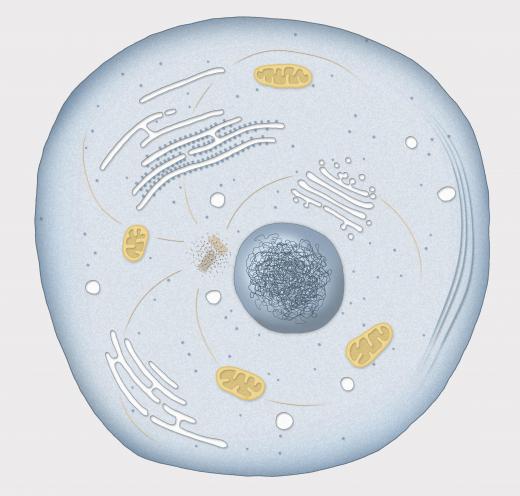What is the Golgi Apparatus?
The Golgi apparatus is an organelle that is present in most eukaryotic cells, which are cells that contain internal structures. It is commonly thought of as the cell's packaging and processing center. Cells produce many different molecules, such as lipids and proteins. After they are produced, they are sent to the Golgi apparatus where they are modified, packaged, and sent away. The Golgi apparatus is commonly compared to a post office.
The Golgi apparatus is composed of stacks of membrane-bound structures known as cisternae. There are typically four to eight cisternae in each apparatus. Each single part of a cisternae, known as a cisterna, is a flattened membrane disc that contains enzymes used for modifying molecules. The whole structure is located between the endoplasmic reticulum, or the cell's “factory,” and the cell membrane. The position and structure of the Golgi apparatus allows materials produced in the endoplasmic reticulum to be quickly processed and “shipped” out of the cell's membrane.

This cellular “post office” plays an integral part in preparing molecules for use both inside and outside of the cell. Its primary purpose is the modification of proteins, which serve vital roles in nearly every biological process. It adds sugars and phosphate groups to proteins, modifying their structures and functions to match their specific tasks. Additionally, it is involved in the transportation of lipids and the production of lysosomes, which contain digestive enzymes that break down substances in cells.

To store and transport molecules, the Golgi apparatus utilizes vesicles. Vesicles are small, membrane-enclosed sacs used for storage, transportation, and digestion. Vesicles are also used for moving substances out of the cell through a process known as exocytosis, in which the vesicle merges with the cell membrane and releases its contents on the outside. They can also merge with cell membranes from outside of the cell and release their contents on the inside. This is known as endocytosis.
Camillo Golgi, an Italian physician, identified the Golgi apparatus in 1898, and the structure now bears his name. While it is vital to the proper functioning of eukaryotic cells, the Golgi apparatus, like most membrane-bound organelles, is absent in prokaryotes. Generally speaking, prokaryotes are much smaller than eukaryotes and have fewer requirements in terms of modification, transportation, and storage. Large, complex eukaryotes, such as humans, have much more diverse needs. As such, it is unlikely that the cell's hard-working post office will be out of a job any time soon.
AS FEATURED ON:
AS FEATURED ON:












Discussion Comments
I really like the Golgi apparatus analogy of it being a post office. I know some of the examples are kind of cheesy at times, but I think as someone learning the organelles and cell parts for the first time, it gives an easy reference point.
I'm not sure, but this may be a silly question, but why would a cell even need to change the proteins and lipids in the first place? What exactly is their function after they pass through the Golgi apparatus and out of the cell membrane?
How many Golgi apparatuses are usually in a normal cell? Are there certain cells that have more of a need to produce enzymes and modify proteins than other cells? They might end up needing more Golgi bodies.
I'm also wondering if there is any difference in the plant Golgi apparatus compared to an animal. My guess is that the cisternae would produce different enzymes since plants and animals need different proteins, but do they look and work the same?
@jcraig - Good question. A vesicle is a more general term for any organelle that stores material to move it around the cell. Vacuoles and lysosomes are both types of vesicles. In general, though, a vacuole is typically thought of as holding water and solutes, not transporting proteins.
My question is: does each one of the cisternae of the Golgi apparatus specialize in modifying a specific protein, or can they all handle the same jobs?
I thought this was really interesting. I remember taking biology class a few years ago, and the Golgi apparatus was always one of the organelles that seemed to get passed over along with the ribosomes and endoplasmic reticulum. I've been reading about a few of these organelles lately, and I'm really surprised by how important they are despite not getting a lot of attention.
This article got me wondering though, what is the difference between a vesicle and a vacuole? I always thought the vacuole did the same job that was described for the vesicle.
Post your comments